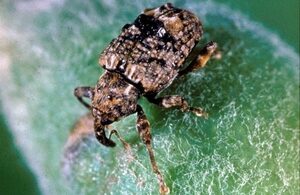Introduction: The first place to address your question is the online materia medica – www.considera.org/matmed – and the less-complete repertory – www.considera.org/rep. The repertory and materia medica are designed so that anyone can consult them and add to them. Everyone can add their experiences on-line or by post.
If you find a remedy, here are some suggestions for how to apply these to the plants:
Kaviraj suggested this: “When I refer to treating plants with homeopathic remedies, this is the standard dosing procedure: Put 20 drops of a 6X potency in a litre of water. Succuss the bottle 50 times. Put this litre in the watering can, fill it up with 19 litres of tap water and stir. If the watering can is smaller, the amount of remedy put in must be proportionally smaller. Thus a 10 litre can needs only ½ litre and just 10 drops of the remedy. Apply the contents of the watering can to the roots of the plants to be treated.”
Christiane Maute has used remedies on pillules and says this in her book “Homeopathy for plants”: for your garden: Crush 6-8 globules in 150 ml of water using a plastic or wooden spoon. This mixture will be divided into 3 parts and used to make 30l of “medicinal water” in all.” (The three parts are because 10 litres is enough to carry but you can add the 150 ml to the 30 litres in one go.)
Mark Moodie says: Try the above. As agrohomeopathy is so young please take these as initial suggestions. In biodynamics we make a distinction between remedies that irrigate a plant and those that are sprayed in the air. Kavi often said you don’t take a shower in the remedy, you drink it and because a plant drinks through its roots that’s why you apply it there. But the stoma on the underside of the leaves are also paths into the plant so I would argue with Kavi. There you have it – a difference of opinion. Perhaps frustrating but I hope you will sigh and take it as a permission to experiment – AND REPORT BACK! (Thanks)
The Plant Doctors
Mark Moodie, Dr. Iftikhar Waris, Pawan Singhania
Hi plant doctor,
I am living in Delhi. I had pruned my roses a month before. Now the problem is that at least 70% of them are dying as the new leaves which came soon dried up.
Can you please suggest what the exact problem is and the remedy?
Thanks
Aaepee
Pawan: Aaepee, you have pruned the roses in the wrong time. While one should prune lightly at the onset of monsoon, the right time to prune is at the onset of winter. In Delhi, it should be sometime in Oct. The leaves stem would die and the leaves would also die, also due to the hot temperatures. This is not a disease; hence I do not think any medicine would help. Cover, the cut end with some fungicide paste immediately after pruning. Always sterilize the pruner before commencing pruning. You can do that by swiping the blades in 40% formalin or heating the blades.
Dear Sir,
I am delighted that homeopathy can cure plant life. In Mumbai, in our locality in Goregaon , there are many rain trees planted on either side of the roads. Over 50 years old, they provide excellent shade owing to a large canopy by the foliage. Lately a large number of these trees are being afflicted by a strange fungal attack. The foliage has dried and many trees have died, leading to their removal. The situation is alarming. Is there a remedy to save these trees?
Regards,
Dr. G.R. Kamat
Pawan: Dr. Kamat, can I presume that the roads have been built around the trees in some recent times. If that be the case, the trees would suffer slow death. The authorities do not have the knowledge that when they cover the root area with metal road, the roots cannot breath. The aerobic microbes do not flourish. The flourishing trees then die a slow death. The only remedy that could save them, if some sane mind with authority could immediately take measures to remove the metal roads around them and allow space for fresh air to penetrate. The soil also should be enlivened by ample amount of organic matter.
Mark: Is Pawan right to assume that the roads have been changed recently? If not, have there been any other changes that would stress the trees? What is the normal life-span of a Rain Tree? Please describe the nature of the fungus and where it is seen (leaves trunk?) and how it spreads – ie. up the tree or from the periphery inwards. What colour is the fungus? Until there are some answers to the above I would give Carbo veg as a ‘corpse reviver’.
Dear Mark and Dr. Waris,
A gardener told us we have termites in some of our trees. Is there a homeopathic approach to this?
Jacqueline Begnoche
Pawan: Hi Jacqueline. Try Asafetida Q. Also put copious water, always keeping the soil wet.
Mark: Consider tanacetum
Dear Sirs,
I have a problem with a lemon/orange cross which I have inside. It is only 45cm high and 2.5 years old. It flowers in Spring and fruit appears but they fall off when still very small (2mm). Any suggestions? I have a chikoo tree four years old, it is flowering every year but does not bear fruit at all. Any suggestions?
Geeta Chauhan – Dehradun India
Pawan: It is called premature fruit drop. It’s a hormonal problem. Use Planofix (or any commercial preparation having alfa Naphalene acetic acid or in short NAA] @ 10ppm when the fruits are of berry size. Repeat after 45 days. Besides keep the plants outside. Allow honey bees and butter flies in your environment by adopting organic methods and restricting use of poisonous sprays. Try to grow plants that would invite butterflies or say create a butterfly garden. Also apply about 100gms of bonemeal at the onset of monsoon, this season and hopefully, you will enjoy your chikoo fruits.
Mark: from the Materia medica Kaviraj suggests Calcarea Carbonica, Carbo veg (also Mexican corroboration), Ferrum Phos, Kali Carb, Nitric acid. Look if any of these meet your requirements
Dear Plant Doctor,
I have Bean Beetles eating my green beans in my garden. They eat the leaves and eventually there is nothing left of the plant. Can you tell me what remedy to use to make the beetles stay away? Also, my tomatoes have aphids. This is a first ever for me in my garden. Is there something I can use for aphids on my tomatoes to kick them off?
Thanks!
Patti
Pawan: Patti, Sprinkle wood ash on the leaves. Place some garlic bulbs around the tomatoes and let them grow. The garlic plants will repel the aphids. Also sow seeds (sporadically) of yellow mustard amongst your tomatoes as companion plants. They will attract the aphids and would spare your tomatoes and also your cauliflowers or cabbage too, if and when you grow them.
Mark: Patti, what has changed this year that you are getting new problems you haven’t seen before? Try ocymum basillicum for the tomatoes and possibly coccinella septempunctata. Put ‘aphids’ in the search page of the materia medica ) and you get a long list of suggestions. For beetles (note spelling: we have no remedy for Liverpuddlian mop heads on your beans) you get a shorter list from which you can make a choice:
| Cantharis | |
| Sulphur | |
| Tanacetum Vulgare | |
| Ment | Mentha Viridis/ Piperita/Sativa spp. |
| Doryphora | |
| Agriotes | Agriotes lineatus |
| Silicea | |
| BD507 | 507 |
| Sim – BT | Bacillus Thuringiensis (BT) |
| Calendula Officinalis |
Mark and Dr. Waris,
My cabbage plants have been developing club root, which is caused by a fungus (Plasmodiophora brassicae) that gets into the root hairs. The roots become deformed and then crack. The plants are really worse from heat and do poorly in the hot sun, despite having enough water. They seem to recover at night when it cools off.
Theresa
Pawan: Theresa, treat your soil with biological fungicide, Trichoderma virridii. You need to mix the innoculum with vermin-compost and allow about 3-4 days to spread within it. Then apply the treated vermin-compost around the cabbage. If you are aware of Biodynamic agriculture, treat your plants with the BD 501, the silica preparation.
Mark: This is notoriously resistant to treatment. I have found only one reference which is from the biodynamic newssheet of 1938 and is a little half-hearted: “When transplanting or dispatching roses, bush or fruit trees it is good to dip the roots into a paste of cow dung, clay and 500. This is also recommended when transplanting cabbages and would probably be a protection against club-root.”
Dear Mark, Dr. Waris,
We lost many strawberries and blueberries last year to grey mold. A grey fungus coats the fruit and they rot before long. One of the recommended treatments is copper based fungicides and we don’t want to use that. The damp weather of course made it worse. Is there a holistic and/ or agrohomeopathic solution?
Thank you
Harold Moran
Pawan: Try to learn and adopt Biodynamic agriculture practices. The BD501 (silica preparation) could enhance the immune system and keep the diseases away. You should be using compost prepared under aerobic condition, at the beginning of summer. Ensure to remove leaves, if they have overgrown and allow free aeration.
Try Silicea 200 spray on the plants, repeating application after 4 and 7 days.]
Hpathy’s Plant Doctors answer questions about houseplants and crops. Send your questions to: [email protected]






I have two big Hibiscus plants in my yard. Every year just about the flowering time a very small snow-white beetle like insect collect under the leaves and spreads so fast. I tried chemical insecticides available in the market but they were resistant to the sprays. The insects practically cover the leaves and tender stems like a mat and the plat withers with all leaves gone and tender branches wilt. They also attacked the “Kadi Patta” plants in the past and a few plants died due to this pest.
I was watching a regional language TV channel which was showing the preparation, and application of bio manures and bio- sprays made from cow dung and cow urine even on large farms like mango, papaya and many other fruit orchards. The results of application of that bio manure and bio spray were astounding. I got a bottle of cow’s urine marketed by Baba Ramdev’s pharmacy store, added a four to five drops of the same to 20 ml water and sprayed then on the Kadi patta plants and on the underside of Hibiscus plants. I repeated this weekly for a couple of weeks and lo! all the white pests had disappeared from both the plants. What surprised me is that while I drenched the small potted kari patta plants with the dilution, I casually sprayed the solution on the big hibiscus plants through a nasal spray bottle which in fact gave a very fine spray instead of a stream of water! And it is now more than three months and not an insect is seen on both the plants. This was a shot in the blind which I took and I was surprised at the results.
Those who have more variety of plants and may be big gardens can try this. The cost is practically nil and the result was astounding. It is so gratifying to note that bio product will help agriculture in such a way. I only hope that Indian agriculture take up this system for better yield and quality products.
sir i bought spindle palm 1 month ago in good condition, and i was change into another pot with sandy soil, now plant are turning brown day to day, whats a problem with this, plls tell me sir how can i save it?